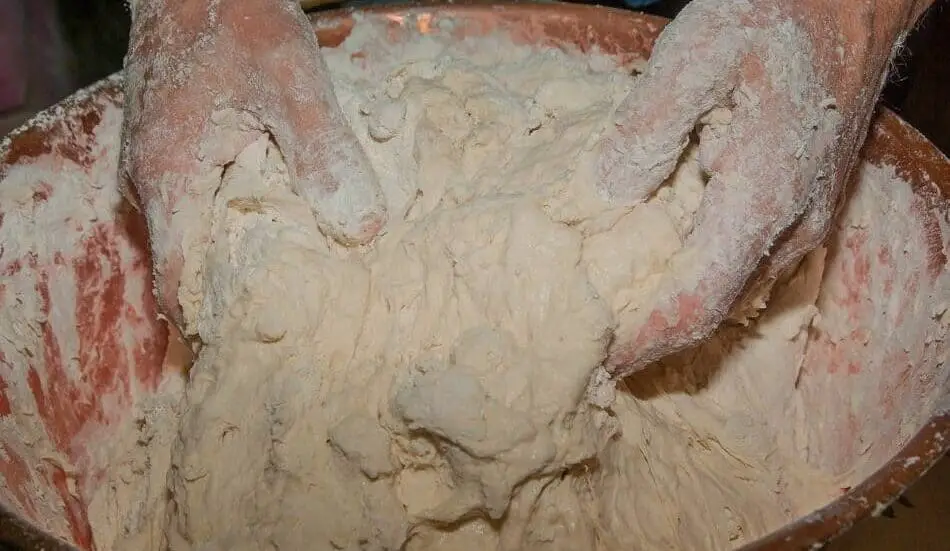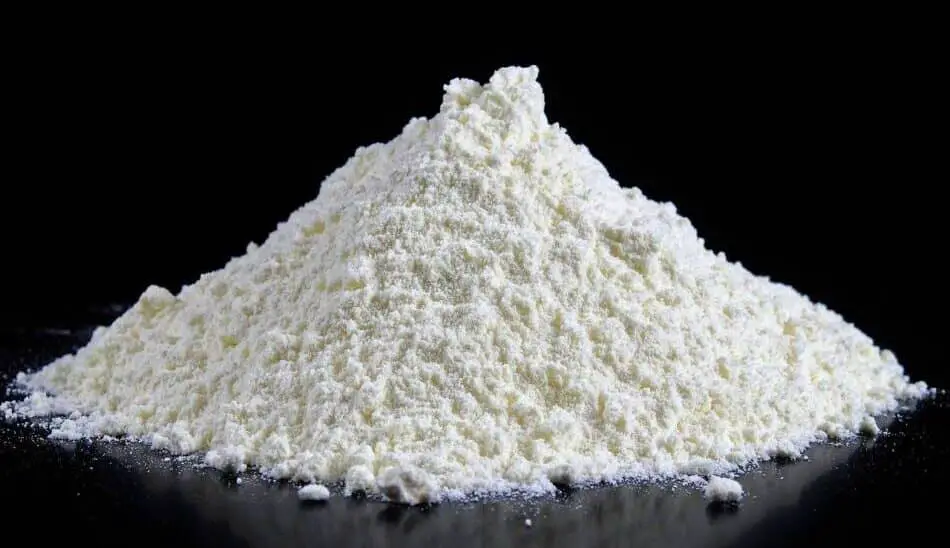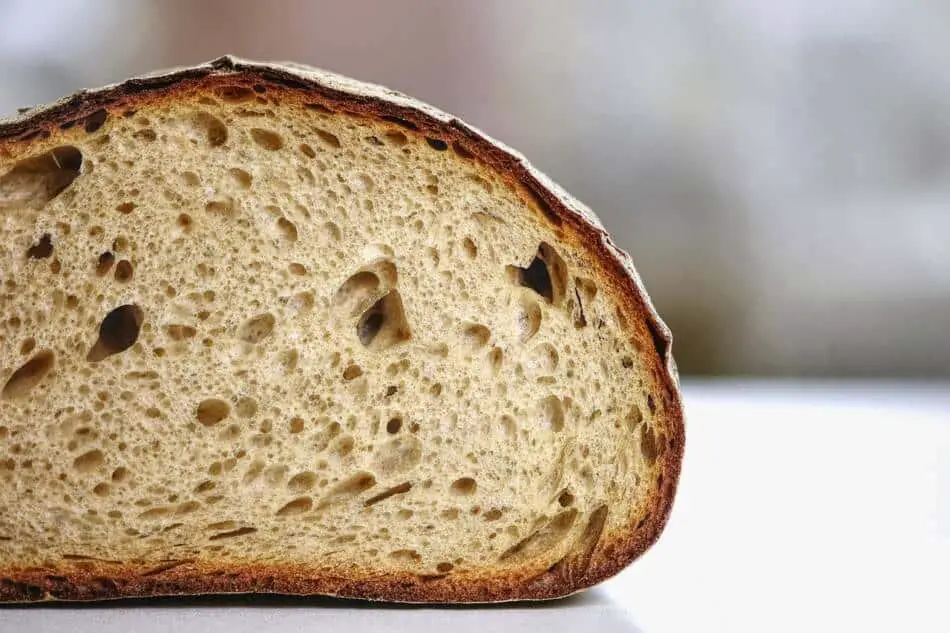Sourdough bread rises because carbon dioxide gasses produced by yeast and bacteria fermentation gets trapped by the gluten network in the dough and the flexible dough expands as its internal pressure increases. However when gluten network is over developed, it can inhibit the dough from achieving a full rise.
The article discusses the three overarching factors that causes sourdough to rise, and provides 15 techniques to help you achieve that perfect rise in your sourdough bread.
The three overarching factors that causes sourdough to rise
1. Gas production from fermentation
| Type of Fermentation | Active Microorganisms | Fermentation Reaction |
| Alcoholic Fermentation | Yeast | Simple sugar –> Ethanol + CO2 |
| Lactic Fermentation | Homofermentative Bacteria | Simple sugar –> Lactic Acid |
| Lactic Fermentation | Heterofermentative Bacteria | Simple sugar –> Lactic Acid + Acetic Acid + CO2 |
To achieve a good rise, the fermentation reaction has to be strong to produce enough carbon dioxide gasses required for the expansion of the dough.
There are three distinctively different fermentation reaction that happens in a sourdough. Only two fermentation reaction releases carbon dioxide gasses into the dough environment by consuming simple sugars produced by amylase enzymes found in the dough.
As the carbon dioxide gasses accumulates in the dough, pressure inside the dough increases and the dough expands, resulting in a rise.
2. Gluten network traps carbon dioxide gasses
To achieve a good rise, the dough must be developed sufficiently to be able to trap carbon dioxide gasses and be free to expand in the oven.
When the gluten network is insufficiently developed, carbon dioxide gasses produced from the fermentation reaction escapes through pores and holes in the dough, the internal pressure in the dough does not increase, and the sourdough does not rise.
3. An extensible dough allows the dough and baked loaf to expand freely
To achieve a good rise, the dough has to be extensible enough that it can expand with little resistance.
There are two main characteristic of a dough that describes it physical structure; elasticity and extensibility. Elasticity is the dough’s stiffness and resistance to stretching, while extensibility is the dough’s ability to stretch without tearing.
There are a few factors which will be discussed below that can cause the dough to be highly elastic with little extensibility. If the dough is too strong and elastic, it resists expansion of the carbon dioxided gasses which leads to a poor rise and dense loaf.
14 Tips to achieve the perfect rise
1. Appropriate mixing time to avoid under-mixing and over-mixing
Flour contains two protein molecules which are glutenin and gliadin that are randomly oriented in all directions. The mechanical motion of mixing aligns and combines these protein molecules to form gluten strands which is also known as the gluten network.The gluten network traps carbon dioxide gasses that is released from fermentation.
When the dough is under mixed, gluten is not adequately formed in the dough and there are spaces in the dough where the carbon dioxide gasses can escape.
When the dough is over mixed, the dough becomes highly elasticity and not extensible; the dough gets excessively stiff. As carbon dioxide fills up the spaces in the dough, the overly strong dough resists the expansion and hence the rise and volume is reduced.
Different types of mixer calls for different mixing time as the shape and movement of the mixing arm of different mixers develops the dough at different rates. We should aim to mix the dough so that it has moderate elasticity and extensibility; the dough should be supple but at the same time has some muscle or resistance to stretching.
The table below is courtesy of Jeffrey Hammelman that wrote the book ‘Bread: A Baker’s Book of Techniques and Recipes’. It gives us a rough guide on the appropriate mixing times when using different mixers to achieve moderate dough strength, reducing the risk of under-mixing and over-mixing.
| Mixer | First Mixing (Minutes) | Second Mixing (Minutes) | Total Mixing Time (minutes) |
| Spiral | 3 | 3 | 6 |
| Planetary | 3 | 7 | 10 |
| Oblique | 5 | 9 | 14 |
| Stand Mixer (KitchenAid Type All Purpose Mixer) | 2.5 | 4.5 | 7 |
| Hand Mixing | 2 | 7 | 9 |

2. Reduce mixing time when using autolyse
Autolyse is a process where flour and water is combined (without yeast and salt) and left to rest for 20 minutes to 1 hour for the flour to be fully hydrated and to increase in strength without any mechanical mixing.
Additionally when autolyse is used in making bread with high content of whole wheat flour, the bran has opportunity to absorb more dough water during the autolyse, which allows the gluten network to be more easily developed as there is less cutting action of the bran on the gluten strands in the final mixing of the dough.
Anytime autolyse is used, be sure to reduce the mixing time. Otherwise, the dough may be overly developed and become too stiff and strong which inhibits the dough to expand and rise freely.
3. Appropriate number of folds
Folding is a very useful technique in sourdough bread as it is highly effective in adding additional strength to the usually wet and sticky sourdough. However, since folding is so effective at adding strength to the dough, we can easily over develop our dough’s strength if we are not careful. When too much fold is incorporated, the dough becomes too stiff and it will inhibit the dough from rising.
Most sourdough breads usually call for 1 to 2 folds over a bulk fermentation period of 2-3 hours; 1 fold consists of the folding of all 4 sides of the dough into its centre.
Certain type of dough deviates from the usual 1-2 folds that is required:
- Dough made with high percentage of pre-ferment (more than 35% total weight of flour) tend to have good strength because of the acidity of the pre-ferments. Too many fold can make the dough too strong, and less extensible hence it will have a difficult time achieving full rise in the oven.
- Dough made with low protein/low gluten benefits from extra folds.
- Dough of a very high hydration (more than 75% total weight of flour) is weak by nature and benefits from extra folds. As more folds are incorporated, the dough is able to trap more carbon dioxide gasses, and the resulting bread volume increases.
- Dough with very low hydration (less than 60% baker’s percentage) do not require folding since they have adequate strength from mixing. However degassing is still necessary to remove any excess carbon dioxide gasses.
4. Adequate degassing
This may seem counter intuitive but it is important to remove any excess carbon dioxide gasses to maintain a healthy rise in our dough and baked loaf. The fermentation reaction produces carbon dioxide gasses throughout the whole baking process from when the ingredients comes together at the start of the mixing phase, to the first 10 minutes of the bake when the loaf enters the oven.
The goal is to maintain healthy fermentation throughout the baking process so that carbon dioxide is produced continually to achieve a good rise up until the loaf enter the oven.
It is important to remove any excessive build up of carbon dioxide by pressing down on the dough firmly during folding, as an excessive build up of carbon dioxide impairs fermentation and the rate at which carbon dioxide gasses are produced, resulting in a dough that has poor rise.
Although the carbon dioxide gasses have been release and the dough is deflated when it is degassed, do not worry about losing these gasses as new carbon dioxide gasses will be produced throughout the bake.
Take oven spring as an example, the dough expands rapidly in the oven as temperature rises during the early stages of the bake partly due to expanding gasses, but also because fermentation gas production rate is at its highest in the oven.

5. Using sourdough starter at the peak of its maturity
We should use sourdough starter at the peak of its maturity as that is when fermentation rate is at its highest. When sourdough starter is too young or too ripe, yeast and enzyme activity decreases, gas production decreases and loaf volume and rise is negatively impacted as well.
Signs of properly ripen sourdough starter:
- Loose sourdough starter (100-125% hydration)
It is fully ripen when the surface is filled with many bubbles. It has over risen when the starter has collapsed, leaving a ‘high water mark’on the surface of the container.
- Stiff sourdough starter (50-60% hydration)
It is fully ripen when the domed surface is beginning to recede in the centre. It has over risen when the domed surface has collapsed.
- Rye sourdough starter
It is fully ripen when the domed surface is beginning to recede in the centre. It has over risen when the domed surface has collapsed.
6. Maintain a healthy sourdough starter
A healthy sourdough starter is filled with yeast and bacteria that are vigorous and active, which ferments well and produces a lot of carbon dioxide gasses. A healthy sourdough starter typically doubles in size in at least 8 hours when left to ferment at 25 Celcius.
Tips to maintain a healthy sourdough starter:
- Feed it once a day
- Storing it in an appropriate temperature of about 25 Celcius.
- Use skins of grapes, potato water, grated onions and honey to introduce a wider variety of microorganisms into the starter
- Do not use bleached flour as it kills off a lot of vital nutrients required for the perpetuation of the starter.
- Do not use high protein flour (more than 12% protein) as it has lesser starch which is an essential food source in the fermentation chain.
- Do not use chlorinated water as they are harmful to the microorganisms in the starter. Let water sit outside for several hours for chlorine to dissipate; boiling does not remove chlorine from water.
If you plan on feeding your starter every alternate day, feed it during the morning, allow it to ripen at room temperature throughout the day, and once ripen, refrigerate it. Then when you are ready to feed the starter again, repeat the same process.
Be sure to remove the starter from the refrigerator and feed it the day before you want to bake, so that the microorganisms has time to be fully active; do not refrigerate the starter the day before you intend to bake.

7. Right fermentation temperature
Fermentation rate and carbon dioxide gas production rate happens best at about 30 Celcius, but do note that it is not the best temperature for flavor development. The temperature balance for adequate gas production (for rise and volume) and flavor development is at about 25 Celcius.
We can achieve the targeted dough temperature of 25 Celcius for bulk fermentation by calculating the required water temperature from taking into account the room temperature, the flour temperature, the pre-ferment temperature, and the friction factor of the mixer.
8. Using dough of higher hydration for better fermentation
A looser and wetter dough ferments better and hence produces more carbon dioxide gasses for the rise of the dough.
The challenge with wetter doughs is that it is more difficult to mix to adequate gluten development; the dough tends to remain excessively slack and moist throughout the mixing process. We can use the bassinage technique for mixing to make it easier to mix and develop gluten in wet doughs.
When mixing, hold back a portion of the water that is called for in the formulation. Mix the dough that contains lower quantity of water first, and once gluten is developed to the desired strength for the drier dough, introduce the remaining liquid to the mix and mix only until liquid is incorporated.
9. Appropriate Steaming
The oven is filled with steam during the bake to help promote a good rise and oven spring in the oven. The steam moistens and lowers the temperature at the surface of the loaf which delays the formation of the hard crust.
Without steam, the initial rapid increase in volume due to oven spring is inhibited because the surface of the loaf heats up too quickly and the hard crust is formed before the oven spring has the chance to fully develop.
More steam is needed if the dough enters the oven under-risen, to ensure the surface remains moist longer, so the bread can rise more.
Less steam is needed if the dough enters the oven over-risen, so that the crust can form more quickly to prevent the bread from flattening out.
10. Using properly aged flour
Under-aged or under-oxidized flour is called ‘green flour’. Sourdough bread made with green flour has poor gluten development and subsequently does not trap carbon dioxide gasses very well, resulting in poor oven spring and poor rise.
Oxidation of the flour is important as it nullifies the negative effects of thiols that inhibits the strengthening of gluten proteins; thiols blocks the development of disulfide bonds which are important to strengthen the gluten proteins.
Without sufficient oxidization, thiols blocks the development of disulfide bonds, which causes the gluten matrix to be under developed as the dough is mixed.
The oxidation of flour can be done artificially through bleaching or it can be left to age naturally for roughly 3-4 weeks.
It is preferable to use unbleached flour that is aged naturally when baking sourdough bread as bleached flour is void of essential nutrients that is required for the fermentation reaction. Sourdough bread made with bleached flour does not ferment well, gas production is reduced and rise of the loaf is reduced.
To ensure that your unbleached flour is sufficiently oxidized prior to baking, allow the flour to rest in a covered but not tightly sealed container for 3 – 4 weeks before using it to bake, which allows the oxygen in the air to infuse the flour throughout this period.

11. Ensure flour has sufficient amylase enzymes
The fermentation reaction that produces the carbon dioxide gasses for the rise of the sourdough requires simple sugars as its food source.
The starches in the flour is converted into simple sugars by naturally present amylase enzymes found in the flour. An adequate amount of amylase enzymes is required for a strong fermentation reaction; when amylase enzymes are insufficient, fermentation will suffer and hence the rise of the dough will suffer.
The falling number of a flour tells us how much amylase enzymes are present in the flour. When the falling number is greater than 300, there is insufficient amylase enzymes in the flour.
We can introduce amylase enzymes into our flour by adding diastatic malt at about 0.1-0.2% of the total weight of the flour. If malted barley is listed as an ingredient in the flour, the flour has been corrected prior to packing and no further malt is needed.
12. Using high protein flour (13 – 14% protein) with heavy grain bread
When baking with whole grain flour or if seeds, nuts and grains are called for in the formulation, using high gluten flour can help improve the rise of the sourdough.
Whole grain flour, seeds, nuts and grains are relatively sharp and as we mix the dough, these sharp bran pieces tend to cut and severe the gluten structure. Mixing time for these doughs are usually longer to compensate for this phenomenon.
Using high gluten flour such as spring wheat flour is beneficial for breads that contains a lot of heavy grains as the extra gluten is able to support this weight. The high gluten in the flour also ensures that the dough is able to trap carbon dioxide gasses for a good rise in spite of the cutting action of the grains on the gluten network.
13. Soak your seeds, nuts and grains
Another way we can reduce the cutting action of our seeds, nuts and grain is by soaking them prior to mixing; soaked seeds, nuts and grains are known as soakers.
Soaking of the seeds, nuts and grains are done in at least equal weight of boiled water so that they absorb moisture, soften and reduces the tendency to break the developing gluten network. As less gluten network is broken, more carbon dioxide is trapped to give a good rise.
Add the soakers at the end of the mix once dough has achieved full gluten development to prevent the grains and seeds from puncturing the gluten structure hence negatively impacting dough development.
14. Using the right amount of salt
One of the function of salt in sourdough bread is that it helps to tighten the gluten structure and enable the dough to develop in strength.
This is important as it enables the dough to hold carbon dioxide gasses, be elastic and extensible. Without salt, dough becomes sticky and slack in texture, making it difficult to work with and sourdough volume and rise is poor.
Becareful not to use too much salt as it is also an inhibitor to fermentation. Salt is hygroscopic (it attracts moisture), which robs water from the cells of the microorganisms that undergoes fermentation. When too much salt is added, fermentation rate is reduced, gas production is reduced and sourdough volume and rise is poor.
A good rule of thumb to follow is to keep the amount of salt used at 1.8-2.0% total weight of flour. It is the sweet spot that allows for adequate gluten structure and good fermentation rate.
Conclusion
We can achieve a good rise in our sourdough by ensuring a strong and healthy fermentation which produces the carbon dioxide gasses that is responsible for the rise. These carbon dioxide gasses needs to be trapped by sufficient gluten development of the dough. Becareful not to over develop the dough as it can become too stiff and inhibit the dough from expanding freely.

